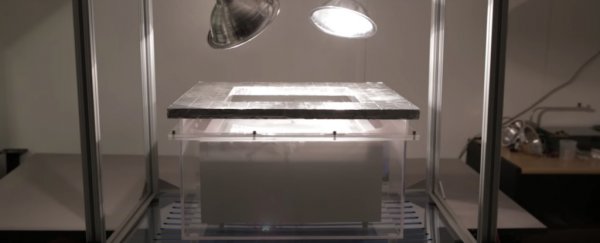When it comes to future challenges, one of the biggest will be water scarcity - on a warming planet we're going to have plenty of seawater, but not enough fresh, clean water in the right places for everybody to drink.
And while a lot of research has focussed on desalination, a team of scientists have now come up with another possible solution - a device that pulls fresh water out of thin air, even in the middle of the desert. All it needs is sunlight.
Called the 'solar-powered harvester', the device was created by teams from MIT and the University of California, Berkeley, using a special type of material known as a metal-organic framework (MOF).
Last year the device was tested on a rooftop at MIT with incredibly promising results.
The first field tests have now been conducted in the Arizona desert, where researchers showed it could collect fresh, drinkable water.
"There is nothing like this," said Omar Yaghi from UC Berkeley, who invented the underlying technology.
"It operates at ambient temperature with ambient sunlight, and with no additional energy input you can collect water in the desert. This laboratory-to-desert journey allowed us to really turn water harvesting from an interesting phenomenon into a science."
The trial was conducted in Scottsdale, Arizona, where the relative humidity drops from a high of 40 percent at night to as low as 8 percent during the day.
The results showed that the harvester could be easily scaled up by simply adding more of the MOF, which absorbs the water.
Right now the current MOF they're using (MOF-801) is made from an expensive metal zirconium and can harvest around 200 ml (7 ounces) of water per kilogram (2.2 pounds).
But Yaghi has created a new MOF based on aluminium called MOF-303 that's at least 303 times cheaper and can capture twice as much water in lab tests.
That means harvesters using the new material could produce more than 3 cups of water per day - roughly half of what a human needs each day.
"There has been tremendous interest in commercializing this, and there are several startups already engaged in developing a commercial water-harvesting device," said Yaghi.
"The aluminum MOF is making this practical for water production, because it is cheap."
Yaghi worked on the first MOF more than 20 years ago. Unlike regular sheets of metals, MOFs are structures where metals such as magnesium or aluminium are combined with organic molecules in an arrangement that creates rigid, porous structures ideal for storing gases or liquids.
Since then, more than 20,000 different kinds of MOFs have been created by researchers around the world, and are already being used to capture CO2, and efficiently store chemicals such as hydrogen or methane.
 UC Berkeley and Berkeley Lab
UC Berkeley and Berkeley Lab
So how does it work?
As ambient air diffuses through the MOF crystals, water molecules attach to the interior surfaces. X-ray diffraction studies of the system have shown that the water vapour molecules often gather in groups of eight, forming cubes.
Sunlight then heats the MOF up and pushes the bound water towards the condenser, which is the same temperature as the outside air. This vapour condenses as liquid water, and drips into a collector to provide clean drinking water.
The team continues to improve the device. We can't wait to see this technology improve further.
The research has been published in Science Advances.
This article was updated from a story published in April 2017.
